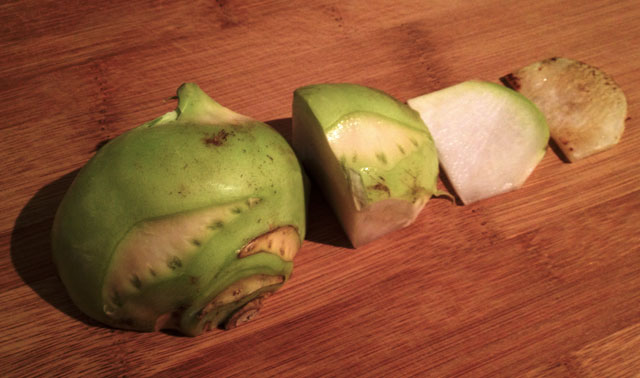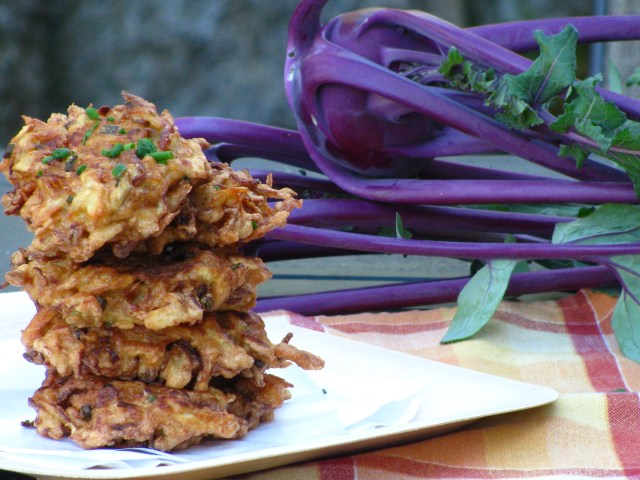If you’re anything like me, you’ve been stuffing your maw with summer’s bounty for the past few weeks. The last berries, the last tomatoes and the last patio cocktails have come and gone. So now, much like the weather, your farmers’ market and CSA bin offerings have faded from their original, bright hues. So what are you supposed to do now? Hibernate until April? Why not reach deep into our root cellars and figure out how to cook what’s left?  One of the vegetables that keeps ending up in my shopping basket, my crisper drawer and eventually my trash is kohlrabi. It’s green, it’s round and it has all sorts of weird branches coming off. I usually pick it up and think, Gee, this looks all sorts of green and healthy! Why not cook it up? But then I never get around to it and I make yet another deposit into my vegetable guilt bank. When you first pick it up, you might think that this bodaciously, bulbous brassica is a bulb. But hold up a second, it is in fact a stem! An incredibly swollen stem. Just like broccoli, it has a fibrous exterior that only gets woodier and tougher with age. So if you get the opportunity to pick your own produce, look for smaller stems to save some shaving time. If you’re buying by the bushel instead of by weight, you might as well pick some up with the leaves intact since they’re edible too!
One of the vegetables that keeps ending up in my shopping basket, my crisper drawer and eventually my trash is kohlrabi. It’s green, it’s round and it has all sorts of weird branches coming off. I usually pick it up and think, Gee, this looks all sorts of green and healthy! Why not cook it up? But then I never get around to it and I make yet another deposit into my vegetable guilt bank. When you first pick it up, you might think that this bodaciously, bulbous brassica is a bulb. But hold up a second, it is in fact a stem! An incredibly swollen stem. Just like broccoli, it has a fibrous exterior that only gets woodier and tougher with age. So if you get the opportunity to pick your own produce, look for smaller stems to save some shaving time. If you’re buying by the bushel instead of by weight, you might as well pick some up with the leaves intact since they’re edible too!

Did you realize that all of those weird spikes were leaves? via Veggie Delight
Even though kohlrabi’s exterior looks decidedly alien, that bright green skin hides a familiar friend. Even though you haven’t tried this exact vegetable before, chances are you’d had something with a similar texture or flavour. I often find the easiest way to approach a new ingredient is by finding its culinary copy and usingthose time-tested techniques to tackle it. After all, if something looks, smells and acts like an ingredient you already know, chances are a purple version will be just as tasty as green! On a botanical level, kohlrabi’s closest cousins are the cruciferous vegetables. After all, kohlrabi does mean cabbage turnip in German. But even though its closely related to broccoli stems, kohlrabi’s potency and texture differ. Its flavour is somewhat cabbage-like, but it’s more dilute than its cruciferous cousins. Whereas raw broccoli is toothsome with a smooth, homogenous texture, kohlrabi has a granular, apple-like crunch. In a pinch you can substitute it for broccoli in a slaw, just keep in mind that it’ll have a milder flavour and a more aggressive crunch.

Just in case you were wondering what lies within. And what lies within when cooked.
If you want to think outside the box and outside of the skin, look deep into kohlrabi’s interior. Once you’ve peeled away its green coat you’re left with a crunch chunk of white. It’s moist and crisp like an apple without crossing into woody jicama territory or crunchy water chestnut land. It’s kind of like that big white radish we played with earlier this year! Swap kohlrabi for daikon if you want some do chua without the bite or a stirfry with a crunch. Just like daikon, kohlrabi holds its own and rarely overcooks, making it perfectly suited to thin soups and hotpots. But unlike that giant, the mild, sweet flavour will rarely overpower a dish. If its mimicking mastery still doesn’t have you convinced, just pretend it’s junk food. After all, what’s the point in eating healthy if it always tastes healthy? Take a cue from our other favourite wintry K-vegetable and make some snacks. You can go the more obvious route and bake the leaves into “kale” chips, but you could also take Martha’s lead and bake “root” chips as well. Or take the time to bread and dredge some kohlrabi wedges and make your own home fries! Its structural integrity means it’s totally down to be shredded, dredged and deep fried into kohlrabi cakes, fritters and latkes too.

What isn’t better deep fried? via Becky in the Root Cellar
But if all of those recipes seem like too much work, just remember that part of kohlrabi’s charm is how forgettable versatile it is. Low in calories but high in fiber and vitamin C, it’s the perfect backup bulk to round out your sparser meals. Cube up some kohlrabi with tomatoes, cucumbers, black beans and corn to bulk out a salsa-like salad without drastically changing the flavour. Take a culinary cue from it’s turnip namesake and shave it into a mild gratin that’ll always hold its shape. Boil it with your potatoes for a different take on a mash. Better yet, just keep it simple and eat it raw with a sprinkling of salt or steamed with a bit of oil. Either way, you’ll have plenty of places to hide your kohlrabi (besides the crisper drawer) by the time you get your next CSA bin.



i like them because they look like little green space invaders. now i know how to cook and eat them! Nice article.
My favorite is dicing them up little with potatoes, and then skilleting them with peas/ the kohlrabi leaves/ some spices. This recipe’s a good one: http://thelocalcook.com/2010/07/07/kohlrabi-with-peas-and-potato/
Obviously I got really into this article
The first time I saw these in a store was in Germany. We grow them in the garden all the time but as soon as they are just below fist size they get picked and eaten raw in the garden (I really never remember ever bringing one in the house, you peel it with your teeth and have a snack). In germany the ones in the store are very big and they boil them up like a potato, remember that it takes a bit longer, like rutabega, and serve with a white sauce on top.
That’s what they are! Food not Bombs always has waaayyy too many and nobody knows what to do with them – until now
I thought this was something very exotic, until I realized what it was. In ye olde courty, we eat them stuffed with (veggie alternatives to) meat and baked or in soup.
:D what this made me realise is that you use the german word for it in english.